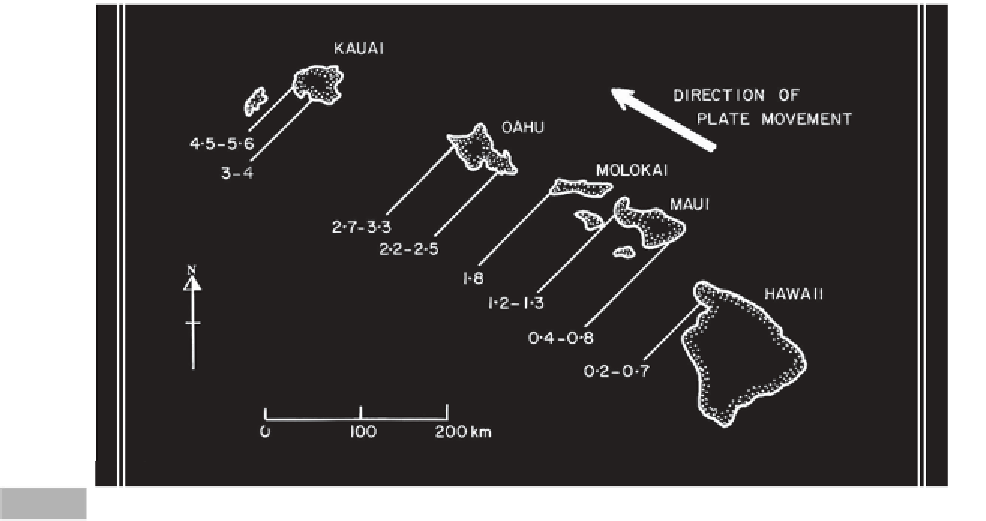Geoscience Reference
In-Depth Information
hypothesis. Figure 9.7 plots the location of main island
strings in the Pacific Ocean associated with drifting of
the Pacific Plate over different hot spots. These hot
spots probably represent the location of upward
flowing convection currents in the mantle that are
responsible for the spreading of plates away from the
East Pacific Rise. Note that not all volcanoes appear
above the ocean surface. Many are submerged. The
Caroline, Tuamotu, Society, and Austral volcanic island
chains all parallel movement of the Hawaiian Islands,
and thus indicate a north-west movement of the Pacific
Plate away from the East Pacific Rise. The Sala-y-
Gomez Island and Galapagos Island chains on the east
side of the Rise indicate migration of plates eastward.
At least 25 primary hot spots have been identified, two
of which lie beneath continental crust under the
eastern seaboard of Australia and Yellowstone in the
United States
The theory of hot spots has fundamental flaws. For
example, the crust under Iceland and the island of
Hawaii, which are viewed as classic examples, does not
have anomalous heat flow suggestive of rising magma.
The site of volcanism in the Canary Islands on the east
side of the mid-Atlantic ridge also does not appear to
be moving with the plate. Instead, eruptions have
occurred randomly beneath the islands. Finally, the
composition of volcanic material discharged above
hypothesized hot spots is not always indicative of deep
mantle material. An alternative hypothesis suggests
Hot
spots
A similar situation to volcano generation at separating
plates can be produced if a hot spot in the mantle
remains nearly stationary over time. A hot spot repre-
sents a long-lived plume of magma 10-100 km in
diameter rising from the edge of the Earth's core
2900 km beneath the Earth's surface. Volcanoes will
develop above the hot spot as crustal material is slowly
melted from below. If a crustal plate drifts over the
pseudo-stationary hot spot, then volcanoes drifting
away from the spot become extinct, and newer vol-
canoes develop in their place. The Hawaiian Islands
owe their origin to drifting of the Pacific Plate
westward over a hot spot (Figure 9.6). This process has
been occurring for over 40 million years. The oldest
activity occurs at Midway Island and a series of
seamounts
northwest of the Hawaiian Islands. On the
latter islands, the active eastern island is about
3-4 million years younger than the furthermost
western and dormant Kauai Island. Rifting in the
Hawaiian area ensures that fractures penetrate to the
magma source below. The melting of crustal material
above the hot spot, and subsequent fracturing and
sinking of the weakened crust, produces this rifting.
The Hawaiian Island chain indicates that the Pacific
Plate has drifted away from the East Pacific Rise
north-west towards subduction zone trenches. Other
island chains in the Pacific Ocean support this
Kauai
Oahu
4.5-5.6
3.0-4.0
Molakai
Maui
2.7-3.3
2.2-2.5
N
1.8
1.2-1.3
Hawaii
0.4-0.8
0.2-0.7
0
100
200 km
Age and direction of movement of Hawaiian Islands drifting over a hot spot (after Muller & Oberlander, 1984).
Fig. 9.6























